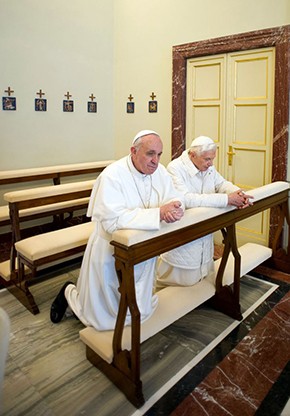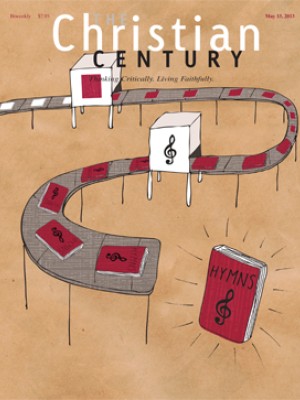Revolutionary continuity

Back in January, few would have imagined that the 40 days of Lent and the 50 days of Easter 2013 would be the opening of a new chapter in the history of the papacy. First Pope Benedict, in the most Benedictine act of his career, retreated like Benedict of Nursia exchanging the commotions of Rome for the austere serenity of a nearby cave. Then a Jesuit from Argentina appeared on the balcony in the guise of a pilgrim greeting other pilgrims, shying away from the pomp of his new role and accepting his election in the spirit of a Franciscan being sent to some far-off mission post.
One pope retired from office, the other pope retired in office, and for the first time in history the world saw two popes embrace. The meeting of these two popes, characterized in the media as “potentially problematic,” was in fact dramatically unproblematic. Whatever awkwardness they may have felt, the mutual deference they demonstrated in praying side by side as brothers eclipsed any thought of intrigue or rivalry between them.
Read our latest issue or browse back issues.
The easiest way to put our minds around the extraordinary series of events that have been unfolding since then is to think in terms of revolutionary change. The words St. Francis heard spoken by Jesus, “Francis, rebuild my church,” echoed in many minds when the pope’s choice of a name was announced; and as the world learned more about Pope Francis’s simple way of life, his devotion to the poorest of the poor and his resolve “to avoid the spiritual sickness of a self-referential church,” we knew we were in for an exhilarating ride. Witnessing the tears of joy as Pope Francis embraces disabled children and adults, the babies passed through the crowds for a papal kiss, the blunt and joyful homilies, the modest lodgings, the arresting humility with which he washed the feet of young prisoners, Christian and Muslim, female and male, I am reminded of Walter de la Mare’s portrait of the Francis-loving G. K. Chesterton: “Knight of the Holy Ghost, he goes his way, / Wisdom his motley, / Truth his loving jest; / The mills of Satan keep his lance in play, / Pity and innocence his heart at rest.”
It is easy to fall in love with this new pope. Though there are reports that Bergoglio as archbishop could be reserved and unsmiling in public, the grace of his election to the papacy has changed all that. A priest who has known Bergoglio well for decades said (in an interview with Vatican expert John Allen), “It’s almost like he’s a different person. He seems ten years younger! It’s as if he’s received a force that he didn’t have before, something almost supernatural.”
It does seem supernatural; there is a sense of a new Pentecost on the horizon. But enchantment can be fickle. Excitement over the change Francis represents may lead us to overlook his equally impressive continuity with his beloved predecessors Benedict XVI and John Paul II. We tend to forget all the babies Benedict kissed, all the disabled and infirm he embraced, all the times he rode open-air through the crowds. Pope Francis speaks of humility, forgiveness, love and ministry to the poor, and it is as if we never heard these things said before. Yet Benedict taught the same law of love in his first encyclical, Deus Caritas Est. Pope Francis can form fast friendships with Protestant, Anglican, Orthodox and Oriental Orthodox Christians, with the Jewish community, with Muslims and with nonbelieving humanists because John Paul II and Benedict XVI laid the groundwork. It is cheering to hear French feminist and agnostic Julia Kristeva express warm feelings for Francis; it was Pope Benedict who first reached out to her and softened her heart.
Those who know Jorge Mario Bergoglio well assure us that the gestures we are seeing—paying his hotel bill, riding the bus, sitting in the back of the chapel at a liturgy for Vatican staff, and in every way short of scandal stepping outside the barriers that separate him from ordinary people—are the essence of this man and of this pope. He is the genuine article. As much as his duties allowed, Bergoglio took to the streets and homes and churches of the villas miserias of Buenos Aires, where parish and gangs compete for bodies and souls. Yet Francis is not a liberation theologian; like John Paul II and Benedict XVI, he has seen firsthand the dehumanizing effect of political utopias. What he has been doing is living according to the vision Pope Benedict articulated in his 2009 social encyclical Caritas in Veritate.
On the first Holy Thursday, Peter said to Jesus, “Lord, do you wash my feet?” and Jesus answered him, “What I am doing you do not understand now, but afterward you will understand” (ESV). So, too, we will understand the actions and gestures of Pope Francis and the manner of his imitation of Christ only afterward, when we look back at these three post–Vatican II pontificates and discover that the differences between Francis, Benedict XVI and John Paul II are swallowed up in the unity of their faith, the example of their personal holiness, and their message urbi et orbi—to the city and to the world.





